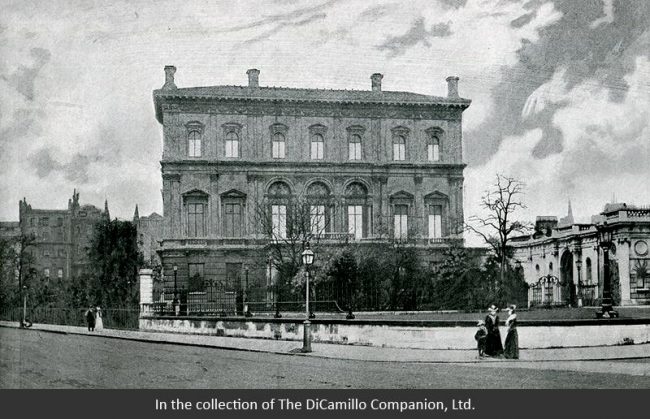
The second house from a 19th century photograph

The marble chimneypiece from the Dining Room, carved 1863-75 by Alfred Stevens for the second house. Today in the collection of the V&A.
Earlier Houses: There was an earlier 18th century house (the first house) on the site that was demolished when the 19th century house (the second house) was built. Some marble mantlepieces from this earlier house were supposedly reinstalled at Apley Park, Shropshire, where they remain today.
Built / Designed For: Robert Stayner Holford
House & Family History: Dorchester House was built as the London home of the great 19th century collector Robert Stayner Holford (1808-92). Erected primarily to display his enormous collection of art, Dorchester House was famous for its luscious, palace-like interiors, including the over-the-top dining room chimneypiece sculpted by Alfred Stevens (considered his masterpiece and today in the Gamble Room of the Victoria & Albert Museum). Holford was a noted collector of books, manuscripts, and fine and applied art, as well as trees and shrubs, which he tended at the famous arboretum at Westonbirt, his country house in Gloucestershire. Holford's architect, Lewis Vulliamy, was told to design a house in which the central feature was a grand staircase. The marble staircase Vulliamy built made Dorchester House one of the most grand and famous residences in London. After Holford's death in 1892 his son and heir, Sir George Holford, decided to lease Dorchester House to Whitelaw Reid, the American ambassador to Great Britain. Reid was famous for his sumptuous receptions and parties, especially the 4th of July celebrations held at the house. It was during this time that King Edward VII and Queen Alexandra, the glittering leaders of early 20th century society, were regular visitors. Dorchester House was demolished in 1929 to make way for the Dorchester Hotel, which was opened in 1931 and continues to occupy the site today. The losses of the great London townhouses were enormous through the first part of the 20th century, but the loss of Dorchester House, complete with its important collections, may have been the greatest loss of all.
Title: Country Houses of Shropshire, The
Author: Williams, Gareth
Year Published: 2021
Reference: pg. 50
Publisher: Suffolk: The Boydell Press
ISBN: 9781783275397
Book Type: Hardback
Title: Victorian Country House, The
Author: Girouard, Mark
Year Published: 1990
Reference: pg. 423
Publisher: New Haven: Yale University Press
ISBN: 0300034725
Book Type: Softback
Title: Biographical Dictionary of British Architects, 1600-1840, A - SOFTBACK
Author: Colvin, Howard
Year Published: 1995
Reference: pg. 952
Publisher: New Haven: Yale University Press
ISBN: 0300072074
Book Type: Softback
House Listed: Demolished
Park Listed: Destroyed
Past Seat / Home of: SEATED AT FIRST (18TH CENTURY) HOUSE: Joseph Damer, 1st Baron Milton and 1st Earl of Dorchester, 18th century. SEATED AT SECOND (19TH CENTURY) HOUSE: Robert Stayner Holford, 19th century. Whitelaw Reid, early 20th century.
Current Ownership Type: Demolished
Primary Current Ownership Use: Demolished
Ownership Details: The Dorchester Hotel sits on the site of Dorchester House
House Open to Public: No
Historic Houses Member: No